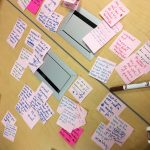By: Charis Lam, Design Research Events Lead
At the Innovation Hub, we believe in designing for student success by listening to their voices. Yet, student success is not a pillar, standing alone. Students move through the university together with, and supported by, staff and faculty. Thus, helping student-facing staff succeed in their roles and feel fulfilled by their careers is important to both staff and students.
The Student Life Professionals (SLP) Network is a community of practice with exactly that goal: offering support to student-facing staff. This year, SLP partnered with the Innovation Hub to ask how it can better serve the needs of all student life professionals at the University of Toronto.
Since November, my team has been analyzing stories shared with us by over thirty staff members through group discussions, facilitated activities, and one-on-one interviews. We picked through the data in search of needs: areas where the journey between a desire (point A) and a solution/execution (point B) is blurred and entangled. The need for better design exists where current ‘solutions’ trip us up. Think of the d’oh moment of pushing a door that’s meant to be pulled. Really, it’s the door that should be clearer.
Our hope is to expand that idea to student experiences—except these are complex and require more responsibility and care than opening a door. During the Innovation Hub training weekend, we learned of the “danger of a single story,” as the novelist Chimamanda Ngozi Adichie put it in her TED talk. We must be careful not to rely on a single story. We must realize that people can go through the same sequence of events and come out with entirely different insights or takeaways. The danger lies in glossing over a story, because it says something different or it’s not presented with the same vivacity and drama as another. Occasionally we must stop, state all the viewpoints we have come across, and list what is important or true about each.
In the context of the SLP project, this means some staff members have differing perspectives on their challenges and needs. Here, we must not question “Who’s right?”, but instead, “What is each person looking for, and how did that affect whether they found it or not?” We try to answer that question to the best of our ability through analyzing the data and support our findings with keywords and quotes within the transcripts.
But, at the same time, we don’t supply clear solutions or answers. As we write the report, we realize it’s full of “Further Questions.” Here is what people are looking for, but is it an exhaustive list? How do we provide them with those things anyway? In a sense, this is where our story ends and our partner’s story continues. We find the needs, as we have been positioned and trained to do, and the SLP Network will find the best way for itself to meet those needs through designing new solutions. Even so, we still have many questions because the stories and experiences we hear have many layers. What people do and want is influenced by other factors, and those have their own causes, which have been influenced by… and so on, the context for understanding others continues to grow.
This can seem daunting, overwhelming, and intractable, but it can also be a source of optimism. There is always more to be done, but then again, there is always more to be done.


0 comments on “Spotlight: SLP Data Analysis”